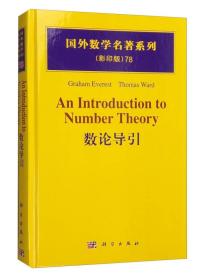
国外数学名著系列78:数论导引
正版现货,首页空白处有印章,内页干净无字迹无写划,如介意有印章请勿拍。
¥ 78 5.7折 ¥ 138 九品
仅1件
作者Graham、Everest、Thomas、Ward 著
出版社科学出版社
出版时间2011-06
版次1
装帧精装
货号h01
上书时间2023-11-23
- 最新上架
商品详情
- 品相描述:九品
图书标准信息
- 作者 Graham、Everest、Thomas、Ward 著
- 出版社 科学出版社
- 出版时间 2011-06
- 版次 1
- ISBN 9787030313867
- 定价 138.00元
- 装帧 精装
- 开本 16开
- 纸张 胶版纸
- 页数 294页
- 字数 370千字
- 正文语种 英语
- 丛书 国外数学名著系列(影印版)78
- 【内容简介】
- An Introduction to Number Theory provides an introduction to the main streams of number theory. Starting with the unique factorization property of the integers, the theme of factorization is revisited several times throughout the book to illustrate how the ideas handed down from Euclid continue to reverberate through the subject. ln particular, the book shows how the Fundamental Theorem of Arithmetic, handed down from antiquity, informs much of the teaching of modem number theory. The result is that number theory will be understood, not as a collection of tricks and isolated results, but as a coherent and interconnected theory. A number of different approaches to number theory are presented, and the different streams in the book are brought together in a chapter that describes the class number formula for quadratic fields and the famous conjectures of Birch and Swinnerton Dyer. The final chapter introduces some of the main ideas behind modern computational number theory and its applications in cryptography. Written for graduate and advanced undergraduate students of mathematics, this text will also appeal to students in cognate subjects who wish to learn some of the big ideas in number theory.
- 【目录】
-
Introduction
1 A Brief History of Prime
1.1 Euclid and Primes
1.2 Summing Over the Primes
1.3 Listing the Primes
1.4 Fermat Numbers
1.5 Primality Testing
1.6 Proving the Fundamental Theorem of Arithmetic
1.7 Euclid's Theorem Revisited
2 Diophantine Equations
2.1 Pythagoras
2.2 The Fundamental Theorem of Arithmetic in Other Contexts
2.3 Sums of Squares
2.4 Siegel's Theorem
2.5 Fermat, Catalan, and Euler
3 Quadratic Diophantine Equations
3.1 Quadratic Congruences
3.2 Euler's Criterion
3.3 The Quadratic Reciprocity Law
3.4 Quadratic Rings
3.5 Units in Z
3.6 Quadratic Forms
4 Recovering the Fundamental Theorem of Arithmetic
4.1 Crisis
4.2 An Ideal Solution
4.3 Fundamental Theorem of Arithmetic for Ideals
4.4 The Ideal Class Group
5 Elliptic Curves
5.1 Rational Points
5.2 The Congruent Number Problem
5.3 Explicit Formulas
5.4 Points of Order Eleven
5.5 Prime Values of Elliptic Divisibility Sequences
5.6 Ramanujan Numbers and the Taxicab Problem
6 Elliptic Functions
6.1 Elliptic Functions
6.2 Parametrizing an Elliptic Curve
6.3 Complex Torsion
6.4 Partial Proof of Theorem 6.5
7 Heights
7.1 Heights on Elliptic Curves
7.2 Mordell's Theorem
7.3 The Weak Mordell Theorem: Congruent Number Curve
7.4 The Parallelogram Law and the Canonical Height
7.5 Mahler Measure and the Naive Parallelogram Law
8 The Riemann Zeta Function
8.1 Euler's Summation Formula
8.2 Multiplicative Arithmetic Functions
8.3 Dirichlet Convolution
8.4 Euler Products
8.5 Uniform Convergence
8.6 The Zeta Function Is Analytic
8.7 Analytic Continuation of the Zeta Function
9 The Functional Equation of the Riemann Zeta Function
9.1 The Gamma Function
9.2 The Functional Equation
9.3 Fourier Analysis on Schwartz Spaces
9.4 Fourier Analysis of Periodic Functions
9.5 The Theta Function
9.6 The Gamma Function Revisited
10 Primes in an Arithmetic Progression
10.1 A New Method of Proof
10.2 Congruences Modulo 3
10.3 Characters of Finite Abelian Groups
10.4 Dirichlet Characters and L-Functions
10.5 Analytic Continuation and Abel's Summation Formula
10.6 Abel's Limit Theorem
11 Converging Streams
11.1 The Class Number Formula
11.2 The Dedekind Zeta Function
11.3 Proof of the Class Number Formula
11.4 The Sign of the Gauss Sum
11.5 The Conjectures of Birch and Swinnerton-Dyer
12 Computational Number Theory
12.1 Complexity of Arithmetic Computations
12.2 Public-key Cryptography
12.3 Primality Testing: Euclidean Algorithm
12.4 Primality Testing: Pseudoprimes
12.5 Carmichael Numbers
12.6 Probabilistic Primality Testing
12.7 The Agrawal-Kayal-Saxena Algorithm
12.8 Factorizing
12.9 Complexity of Arithmetic in Finite Fields
References
Index
相关推荐
-

国外数学名著系列78(影印版):数论导引
九品开封
¥ 70.00
-

国外数学名著系列78(影印版):数论导引
九五品成都
¥ 118.00
-

国外数学名著系列78(影印版):数论导引
九五品郑州
¥ 158.00
-

国外数学名著系列78(影印版):数论导引
全新宁波
¥ 388.00
-

国外数学名著系列78(影印版):数论导引
九品常德
¥ 236.00
-

国外数学名著系列78(影印版):数论导引
八五品东莞
¥ 70.00
-

国外数学名著系列78(影印版):数论导引
全新北京
¥ 148.00
-

国外数学名著系列78(影印版):数论导引
九品天津
¥ 95.00
-

国外数学名著系列78(影印版):数论导引
全新济南
¥ 280.00
-

国外数学名著系列78(影印版):数论导引 (版权页缺失)
八五品济南
¥ 78.99
— 没有更多了 —













以下为对购买帮助不大的评价